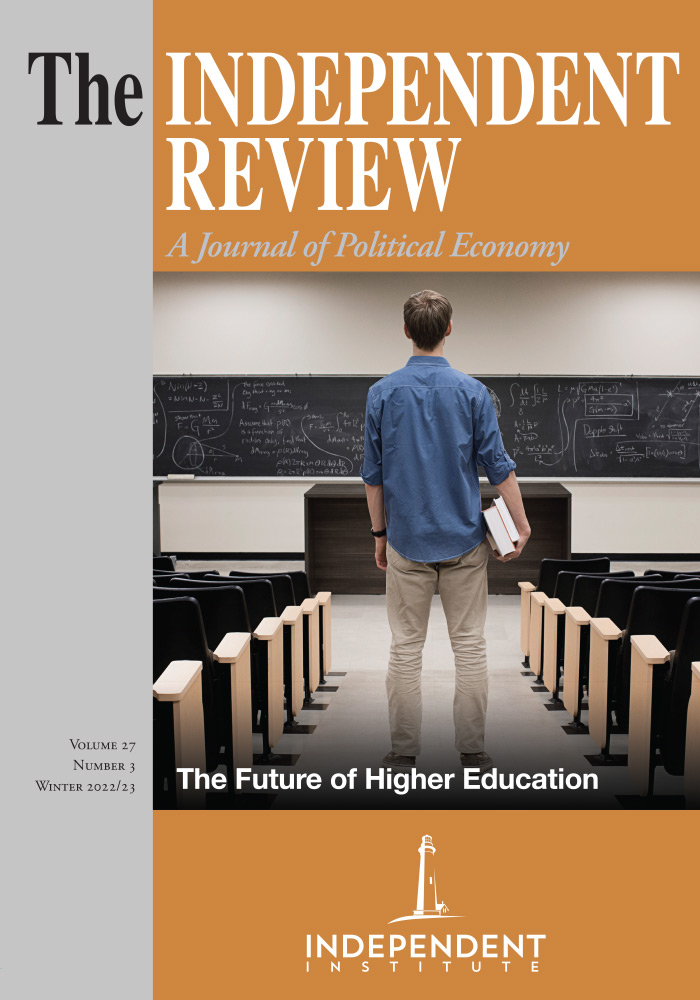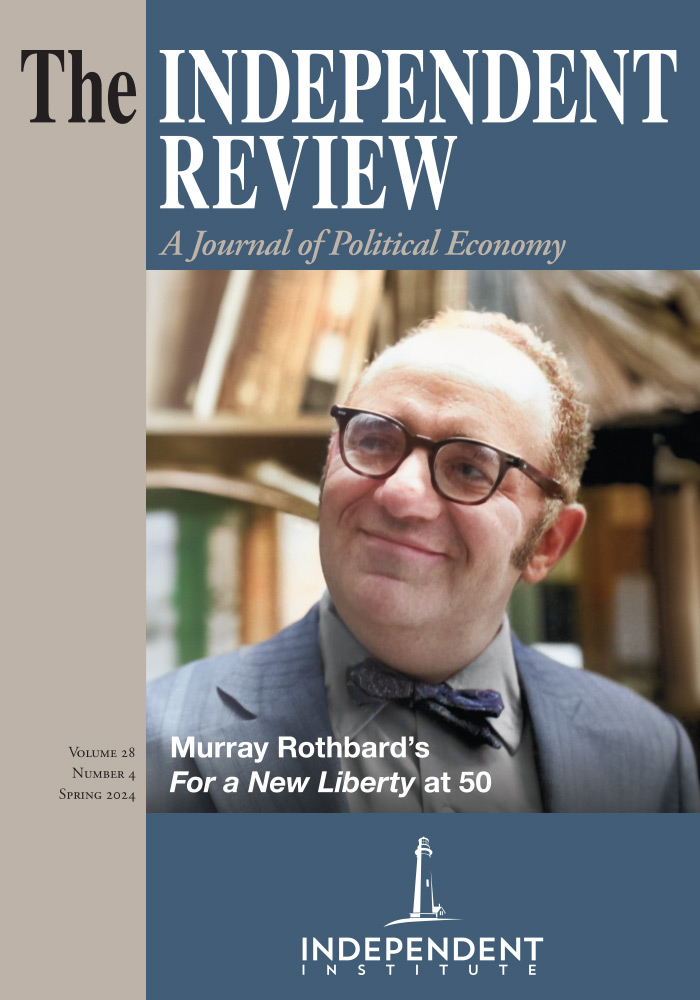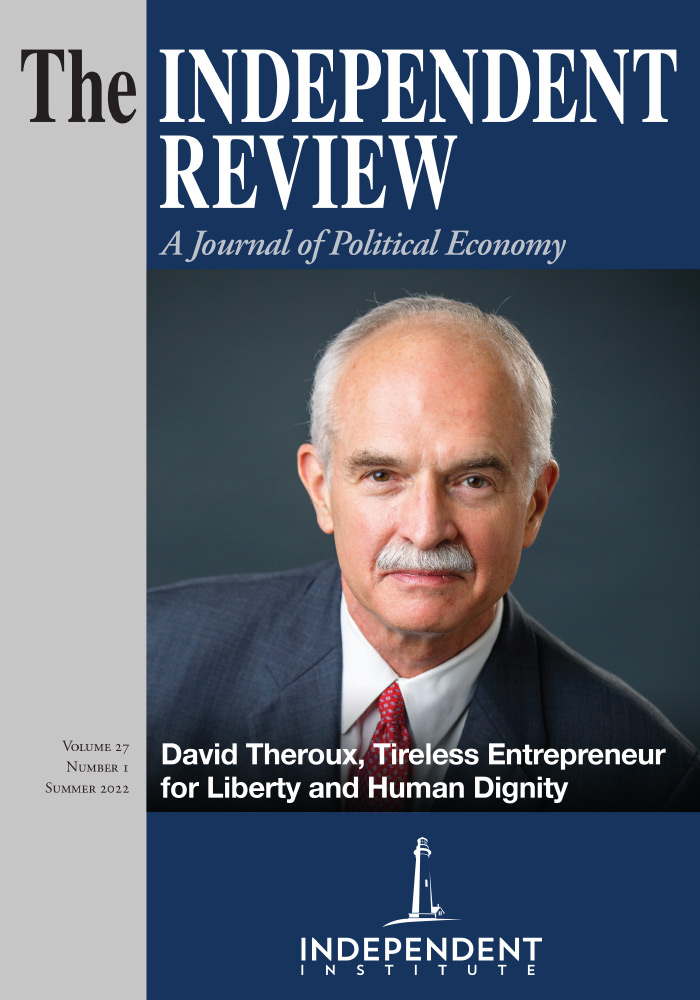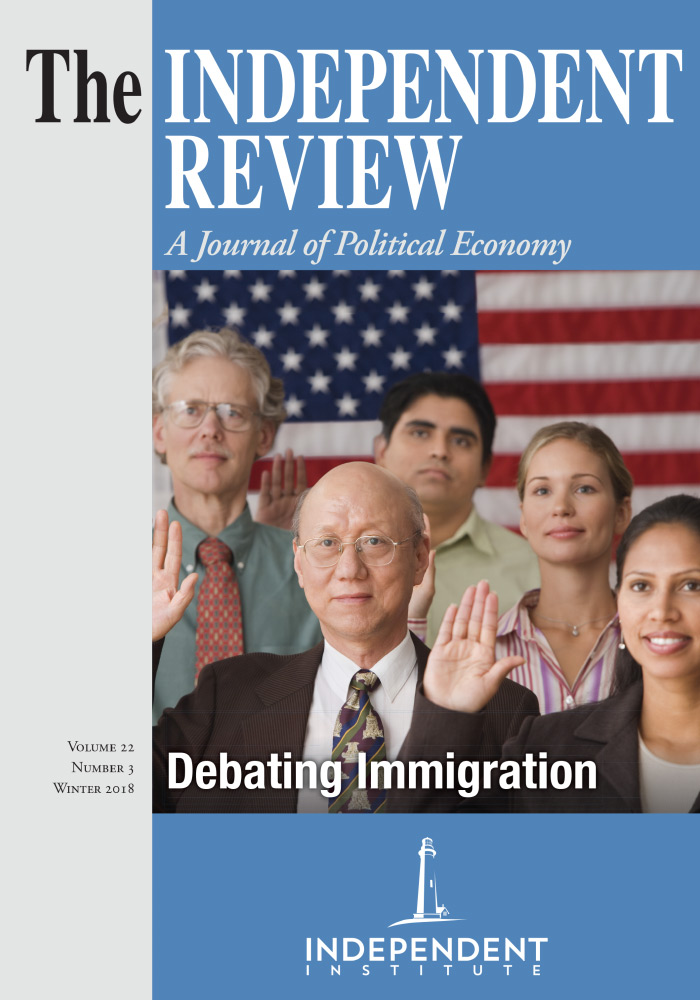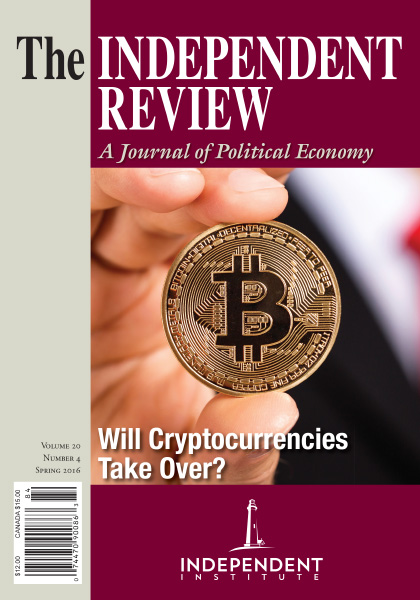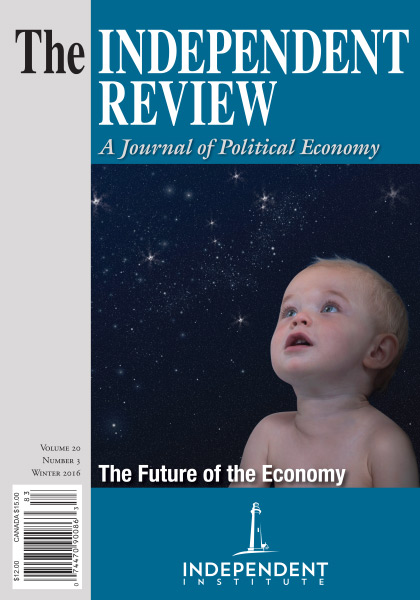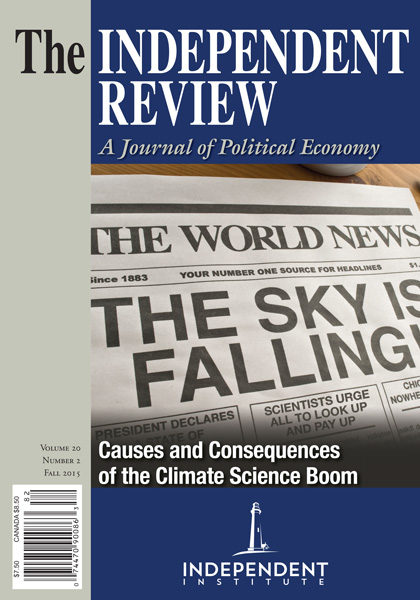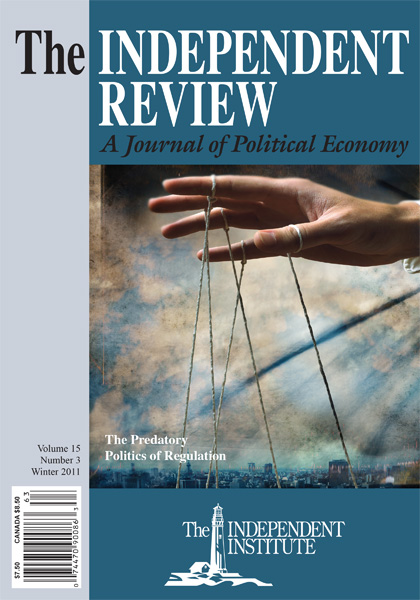What are the key problems higher education will face over the next thirty years? Can they be fixed? Will they be fixed? How? What will be the biggest opportunities for higher education in the next three decades? How can it successfully grasp them? How will higher education change? How should it change? This issue of The Independent Review contains nine thought-provoking responses to these questions.
Article
Critics say that American higher education has significant flaws and that these flaws will only worsen in coming decades. Others say that American higher education continues to improve and that it is the best in the world. What do you think? What are the key problems higher education will face over the next thirty years? Can they be fixed? Will they be fixed? How? What will be the biggest opportunities for higher education in the next three decades? How can it successfully grasp them? Bottom line: How will higher education change? How should it change?
This issue of The Independent Review contains nine thought-provoking responses to the questions posed above. The authors’ essays, which we limited to around 3,500 words and so cannot fully answer all the questions, are intended to help guide a discussion that is vital to American society and to the American economy. We begin with essays by scholars who have spent their careers examining higher education and envisioning its future, and we close with administrators who have grappled daily with the challenges of implementing their own visions.
Richard K. Vedder, senior fellow at the Independent Institute and author of Restoring the Promise: Higher Education in America (2019), begins the symposium with a brief but authoritative overview of the good, the bad, and the ugly of American higher education. American higher education’s strong points include research excellence—the US is home to sixteen of the top twenty-five universities in the world, ranked by research strength—and its decentralized structure, “with many different educational philosophies and specialties, competing often fiercely with other educational enterprises.” However, higher education in the US is increasingly expensive and increasingly inefficient. Enrollment is falling, partly because of rising college prices and an increased awareness of the financial risks of attending college. Far worse, time spent by students on academics—reading, writing, studying, learning, and thinking—continues to ebb, while grades continue to climb. The ugly face of higher education is a loss of academic freedom and intellectual diversity on our campuses. Vedder predicts that “residential colleges and universities will survive, although possibly with significant changes in the form of educational delivery,” and he closes with about a dozen predictions of what the future will bring, including a weakening of tenure and an expansion of federal control.
Amanda L. Griffith, who regularly teaches a course on the economics of higher education and serves on the editorial board of the Economics of Education Review, asks why the price of higher education continues to rise—highlighting its dependence on high-skilled labor, whose cost continues to rise, and increased demand by students and their parents for higher quality education and more expensive experiences from their colleges and universities. She warns that these growing costs have eroded taxpayer support for higher education and predicts that higher education will respond with cost-cutting measures, such as the increasing use of non-tenure-track instructors, online teaching, and larger class sizes. However, she worries that these moves may erode quality and cautions that universities and colleges must not overcorrect.
George C. Leef and Jenna A. Robinson, both with the James G. Martin Center for Academic Renewal, an organization dedicated to improving higher education, “foresee a whirlwind of Schumpeterian creative destruction in higher education in the next thirty years,” similar to what occurred in the telecommunications industry over the past four decades. A few higher education sectors will be insulated from these changes, especially professional degree programs in law, medicine, and other fields that are protected by regulatory barriers to entry. However, most colleges and universities will need to adapt as more and more employers stop demanding college credentials, learning becomes “unbundled,” and mastery supplants the credit hour as the primary determinant of course completion. This reorientation of career education will be complemented by continued innovation in the “learning for its own sake” sector. “Old models of postsecondary education are not suitable for most students,” so Leef and Robinson predict that “the country is about to turn sharply away from the postsecondary education model that has dominated since 1965 and experience a burst of educational innovation that will force most institutions either to adapt to a far more consumer-driven marketplace or wither away.”
Next, Phillip W. Magness, coauthor of Cracks in the Ivory Tower (2018), and David Waugh—both at the American Institute for Economic Research—document the “hyperpoliticization” of higher education. Since the first systematic surveys of the political outlooks of faculty members, college professors have self-identified as standing to the left of the American population, with about 45 percent identifying as “liberal” or “far left” in both 1969 and 1998. However, since then they have made a hard left turn. In the most recent survey, 60 percent identify as “liberal” or “far left.” In fact, the “far left” are now 11.5 percent of faculty members and are as numerous as those identifying as “conservative.” Magness and Waugh argue that it is not necessarily problematic for professors to all lean one way or the other politically, as long as they are committed to free and open inquiry. However, this supermajority of left-leaning academics is responsible in recent years for rampant discrimination against non-left job seekers, both conservatives and moderates, and the trend is likely to worsen. “Faculty who embrace and defend this shift do so at their own peril, as they invite greater democratic oversight of their activities.... The only remaining question, then, is how long the public will continue to pay for a university system that no longer aligns with its values and educational priorities.”
Emily Chamlee-Wright, president of the Institute for Humane Studies and editor of Liberal Learning and the Art of Self-Governance (2015), and Bradley Jackson, vice president of policy at the American Council of Trustees and Alumni, are less concerned about the political shift described by Magness and Waugh, because they believe there are far more truly “liberal” scholars on campus than is commonly recognized. By “liberalism” they mean a “mindset, a cultural ethos that privilege[s] openness, curiosity, ingenuity, and intellectual humility.” Their central argument is that “liberal scholars—left-of-center liberal, classical liberal, and small-government conservative scholars—are not combatants in a culture war. They are caretakers of the tradition that makes the open university possible.” The “culture war” metaphor is misplaced and destructive, as it “feeds a vicious cycle in which illiberalism at one ideological extreme justifies illiberal tactics on the other, causing both sides to abandon the core principles that underlie the ideal of the open university.” College faculty need to live up to their highest calling and encourage, model, and stage “deliberative conversations,” knowing that “when liberalism fails and authoritarianism takes the reins ... they stifle the mind and smother emergent ideas.”
Philosopher Harry Brighouse, coauthor of Educational Goods: Values and Evidence in Decision-Making (2018), seconds Chamlee-Wright and Jackson’s conclusions about the importance of deliberative conversations. As political polarization deepens and political toleration wanes, more than half of college students say that they always or often withhold views on political and social issues in the classroom due to potential consequences—and the fraction among conservatives, moderates, and liberals differs by only a few percentage points. Some self-censoring is a good thing, as classrooms shouldn’t be arenas in which people say whatever they want but can be places where students learn the skills needed for respectful and engaged deliberation. Unfortunately, they don’t learn these skills in college because professors don’t know how to teach them. Brighouse closes by describing The Discussion Project at the University of Wisconsin–Madison, which puts significant resources into development of high-quality professional training in leading productive cooperative deliberations and creates large incentives for faculty to use them. Such programs require a serious investment of resources and need the support of campus leaders. However, “you don’t have to wait for your campus to create its own version of ... The Discussion Project. You can work with colleagues interested in improving their own instruction” and get the ball rolling yourself—for the sake of your students’ future and that of the nation.
Scott Beaulier, dean of the College of Business at the University of Wyoming and former dean of the College of Business at North Dakota State University, returns to the themes of rising tuition and loss of relevance in America’s colleges and universities. The “crisis” in higher education can be tied to demographics, failure to meet workplace needs, disruptive technologies, and student disengagement, but Beaulier focuses on a fifth “driver of decline”: “ourselves—the faculty core of higher education institutions, which ... has, in recent decades, shown greater tendencies toward complacency, entitled mindsets, and intolerance.” He describes his own decisions as a dean, which have been informed by classical liberal intellectuals and mainline economists. He has followed Adam Smith in an effort to reestablish an optimal level of shared governance, which is “neither laissez-faire nor micromanaging.” This approach encourages people to solve problems on their own, promotes greater engagement beyond academia, and reduces barriers to education (including reducing entry requirements for the business major at NDSU from sixty credits to just five courses). He calls on administrators to change their outlook as planners, away from being “engineers” toward being “gardeners” who “put the right people in the college’s garden, nurture good conversations, and make sure everyone is aligned on broad goals and shared vision.”
E. Gordon Gee and Joshua Hall, president and dean of the College of Business and Economics, respectively, at West Virginia University, consider how to stop the value of higher education from falling in a world where tuition is rising, and wage premiums are stagnant. Like Beaulier, their advice is that for American higher education to be successful in the coming decades it must continually strive for efficiency. This seems obvious to any businessperson (or someone running their own household), but “nonprofit firms are at a disadvantage compared to for-profit firms due to a lack of internal discipline driven by the residual claimant.” Even though efficiency is rarely in the self-interest of any individual agent in higher education, leaders must break old habits to minimize bureaucracy, focus on value creation, and take seriously their mission to their students, taxpayers, and the general public.
Finally, Russ Roberts, the host of EconTalk and president of Shalem College, explains that “real education goes way beyond a great scholar sharing insights in an entertaining fashion” (emphasis added). Real education is like learning to fish—it involves hands-on learning, with the learner taking the fishing rod, rather than watching the teacher fish. Real learning realizes that “the brain is not a vessel to be filled, but a fire to be kindled,” as Plutarch said. This kind of learning is not easy. “It requires the teacher to step aside more often than our egos would prefer. We know so much, those of us at the front of the classroom. We have so much to share. We want to shine. But the goal is not to show how much we have to share. It’s to kindle the fire. The goal is to learn from the text not about it.” Roberts wishes that he “could write that ... examples of real education are the future. Alas, they are mostly in the past ... One reason is that real education is expensive. It requires learning to take place face-to-face in small groups.” The problem seems to be that “the educational process is not designed for learning but for teaching, and they are not the same thing.” Can this type of education flourish in the future? Perhaps it can, just as craft breweries are thriving and eating away the market share of the likes of Anheuser Busch.
Before you turn to the essays, let me share my own thoughts on the questions that have prompted this symposium.
I am skeptical of arguments, prominently made by Arthur Levine and Scott Van Pelt in The Great Upheaval: Higher Education’s Past, Present, and Uncertain Future (2021), that there will be fundamental changes in higher education in the next few decades. They argue that higher education is essentially an information delivery system, akin to the music industry, the film industry, and the newspaper industry, all of which have undergone intense creative destruction in recent decades. The music industry has undergone wholesale changes as live music confronted a series of new technologies that were excellent substitutes for it and then for each other: radio, recorded music, digital music, and streaming services. In the middle of the twentieth century, the film industry was faced with a game-changing new substitute in television; later came cable TV, and online entertainment. Most dramatically, the newspaper industry has collapsed in the face of competition from broadcast news and especially online substitutes for its mix of information and entertainment. Levine and Van Pelt think the same fate awaits higher education if it doesn’t reinvent itself.
I am unconvinced. Too many of higher education’s customers don’t want it to fundamentally reinvent itself. They think it already works well. Music, film, and—to a substantial degree—newspapers too are primarily about entertainment and provide fairly passive experiences for most consumers. Higher education is nothing like this. If traditional higher education institutions were like this, new technologies and new competitors would have already made substantial inroads and eroded its market dominance. Higher education requires a lot of heavy mental lifting, so few people learn as much through non-traditional systems, such as MOOCs (massive online open courses) or smartphone apps, unless they are unusually motivated or intelligent. Traditional higher education works much better at imparting knowledge due to its face-to-face aspect, which holds attention better and makes things personal in multiple ways: “I don’t want to look bad in the eyes of this teacher. I will force myself to buckle down because I don’t want to look bad in my own eyes. I want to impress my parents, my classmates, and my future employers. Education is not a game or a leisure activity. The grades matter. The outcomes matter.”
Levine and Van Pelt predict much “unbundling” of education in the future. I suspect that there will be marginal movement in this direction, but the “bundle” of traditional American higher education has proven to be very cohesive. There are incredible complementarities in institutions that combine classroom learning with the rest of the college experience. As Michael Munger (2020) puts it, “[C]lasses are less than half the story. It’s a cliché that some students come to college for the parties, and then stay for the classes, but to see college only as a course delivery system is risible. There are sources of values—both benefits and sensibilities—that will make college matter more than ever as the outside world fragments.” Munger represents the appeal of traditional colleges through four hallowed campus structures: the clock tower (shared experiences that must be scheduled to be shared), the stadium (people are tribal and like belonging), the student union (organizations, clubs, “affiliations” are vital; I met my future wife at my college student union, a framed picture of which hangs on my office wall), and the admissions office (which certifies that the student—eventually the graduate—has the right stuff). “Attracting students to a bricks-and-mortar campus requires a mix, or bundle, of services that cannot be easily replicated, even piecemeal, and which nowhere are available as a bundle with such convenience,” concludes Munger. I agree. Unbundling is much easier said than done, especially when much of the economic payoff from education comes from its role as a signal, as Bryan Caplan (2019) argues.
The administrators who run traditional colleges and universities aren’t as stupid and inflexible as their critics make them out to be. If these schools were such lost causes, would their alumni be so faithful? If they face such a dismal future, would fifty-three public and eighty-three private universities and colleges in the U.S. have endowments exceeding $1 billion (NACUBO 2021)? Collectively these billionaire institutions have endowments of $728 billion. Yes, some smaller, lower ranked colleges have gone out of business in recent years, but I am struck by how absolutely low the rate is. Higher Ed Dive (2022) tracks closings, mergers, acquisitions, and other consolidations, reporting only seventy-six since 2016. That’s about eleven per year among the approximately four thousand degree-granting postsecondary institutions in the U.S. Maybe that will pick up a bit, but can you name another industry with such a low rate of exit?
If the exit rate picks up, I suspect that the primary cause will be demographics, not competition from new non-traditional entrants. Higher education will need to adapt to the falling total fertility rate in the U.S. and around the world. Enrollments are already falling (Moody 2022), the U.S. Census reports that the population under age eighteen fell about 1.5 percent from 74.2 million in 2010 to 73.1 million in 2020 (Ogunwole et al. 2021), and this trend will likely accelerate. Nicholas Eberstadt (2022) puts it this way: “All around the world, people have more of almost everything, from income and education to housing, appliances, and free time—almost everything, that is, except children,” as we have lived through “a revolution in human desires.” Two-thirds of the world’s population now lives in countries whose total fertility rate is below the replacement rate. The Pew Research Center (Brown 2021) reports that a large and growing number of adults just don’t want to have children. In 2018, 37 percent of nonparents aged eighteen to forty-nine said they were “not too likely” or “not likely at all” to have children someday. This rose to 43 percent in 2021. Among them, 56 percent said it was because they “just don’t want to have children.” I suspect that this worldwide trend will grow. The total fertility rate for the U.S. is now 1.78 children born per woman. I predict that this rate will fall well below 1.5 within the next couple of decades. Lyman Stone (2021, Figure 3) notes that birth rates continue to fall from cohort to cohort and uses these trends to project that American women born between 1997 and 2006 will have a total fertility rate of about 1.4. Eighteen nations—including China, Japan, South Korea, Taiwan, Poland, Spain, and Italy—are already below the total fertility rate of 1.5 children born per woman. The “just don’t want to have children” effect may be partly driven by endocrine-disrupting chemicals that have become ubiquitous in the modern world and are impacting other species, as well (Swan 2020). Again, the people who run our colleges and universities aren’t as stupid and inflexible as their critics make them out to be, and they will have plenty of time to adapt to these demographic changes, which are unlikely to require them to fundamentally change. Incumbent higher education institutions also have a good track record of erecting barriers to entry, using accreditation to keep out the competition (Hall 2012).
The deepest problems of higher education in the coming decades are unlikely to arise from outside—new competitors, new consumer demands, and demographic factors—but from within. I agree with Chamlee-Wright and Jackson that the ultimate purpose of higher education is to foster the liberal arts—the arts that teach us how to be free (liber) rather than servile. I agree with Magness and Waugh that our faculties are becoming overly politicized. (What will happen if STEM fields become so politicized that our international rivals take the lead in science and technology?) I agree with Brighouse that we can model and teach respectful and engaged deliberation. But our colleges and universities are increasingly afraid to do this, so the trend is heading in the wrong direction. I don’t think they will fix these problems on their own. As Williamson Evers (2021) puts it in his informative annotated reading list “America’s Higher Education’s Maladies and Remedies,” because the “dons of higher education aren’t willing and able to implement the reforms necessary to change the tide, it’s incumbent on alumni and the general public to exert appropriate pressure.”
The headline failures of higher education are too little learning and high costs, but the much deeper problem is the failure to cultivate moral reasoning—offering a debasement of it and an attack on the foundations of civilization and justice instead. The goals of most administrators are measurable financial success, “a customer who is happy with his product,” and “diversity, employability, and global awareness” among graduates (none of which are bad things in themselves). However, the “assessment regime” cannot effectively assess what matters even more—things like “Platonic experiences [inward reflection], Aristotelian practices, or Thomistic illuminations” (Trepanier 2022).
Higher education has shied away from existential questions. What is the purpose of life? What is true human flourishing? How can we achieve it? What happens to us after we die? We’re afraid to ask these questions. Instead, we stand feebly by as our wards succumb to innumerable, growing distractions. Instead of making cell phones, the internet, and social media part of a balanced diet, young people (abetted by their parents and teachers) have become addicted, frittering away their irreplaceable time. Many cannot tear themselves away from their devices long enough to enjoy meaningful interactions, despite the fact that “more than 60 percent expect they would be healthier and happier without cell phones, and more than 40 percent wish they had the self-discipline to shut off their devices and quit social media” (Adams 2021, 17). Jeremy Adams, a veteran high school teacher, convincingly argues that the current generation of students has increasingly become self-absorbed and nihilistic: “they accept the post-modern conceit that the self does not need instruction. The modern self needs only validation and is not ashamed of seeking satiation.... In the reflection of the Almighty Mirror, where the young behold themselves ... there are no universal laws of moral behavior, the self is not to be judged; and there is no purpose, no telos, no higher goal after which we should strive.” This is largely because “at every level, institutions” including the educational system “that restrained the excesses of individualism in the past are now in retreat” (Adams 2021, 11–12). The children of the current generation of students are likely to face even larger distractions and suffer even greater loss of meaning.
Perhaps the biggest challenge of higher education in the coming decades isn’t dealing with high costs or new competition, but in educating generations that are losing their way. What is education (or, “leading out,” from the Latin educere) if not an opportunity for educators and their institutions to teach young people how to think and how to live—to lead them out of ignorance and immorality towards truth and virtue? I will close with an email I received not long ago that exemplifies this trend: “I was advised by my counselor to email my professors and explain what happened last week and what I am currently going through as of now. Mainly so it gives me peace of mind that as my professor, you don’t have this negative view of me (aka a drunk college kid or druggie). About three weeks ago I had to get an IUD placed in me, since birth control pills were putting me at risk for a stroke. Ever since I had the placement, I have been in a lot of pain; last Wednesday it became unbearable ... So student health sent me to the emergency room.”
American higher education has many strengths, but perhaps the greatest challenge it will face in the future is an American culture that puts more and more young people in unbearable pain and seems to be bent on sending them to the emergency room.
References
Adams, Jeremy S. 2021. Hollowed Out: A Warning about America’s Next Generation. Washington, D.C.: Regnery.
Brennan, Jason, and Phillip Magness. 2018. Cracks in the Ivory Tower: The Moral Mess of Higher Education. New York: Oxford University Press.
Brighouse, Harry, Helen F. Ladd, Susanna Loeb, and Adam Swift. 2018. Educational Goods: Values and Evidence in Decision-Making. Chicago: University of Chicago Press.
Brown, Anna. Growing Share of Childless Adults in U.S. Don’t Expect to Ever Have Children. 2021. Pew Research Center.
Caplan, Bryan. 2019. The Case against Education: Why the Education System Is a Waste of Time and Money. Princeton, N.J.: Princeton University Press.
Chamlee-Wright, Emily, ed. 2015. Liberal Learning and the Art of Self-Governance. New York: Routledge.
Eberstadt, Nicholas. 2022. The Future of Global Population. American Enterprise Institute.
Evers, Williamson M. 2021. American Higher Education’s Maladies and Remedies: An Annotated Reading List. Independent Institute.
Hall, Joshua C. 2012. Higher Education Accreditation: Market Regulation or Government Regulation. The Independent Review 17, no. 2: 233–38.
Higher Ed Dive. 2022. A Look at Trends in College Consolidation since 2016.
Levine, Arthur, and Scott Van Pelt. 2021. The Great Upheaval: Higher Education’s Past, Present, and Uncertain Future. Baltimore: Johns Hopkins University Press.
Moody, Josh. 2022. A 5th Straight Semester of Enrollment Declines. Inside Higher Ed. May 26.
Munger, Michael. 2020. After the Virus, Universities Will Survive. American Institute for Economic Research, April 28.
NACUBO (National Association of College and University Business Officers). 2021. U.S. and Canadian 2021 NTSE Participating Institutions Listed by Fiscal Year 2021 Endowment Market Value, and Change in Market Value from FY20 to FY21.
Ogunwole, Stella U., Megan A. Rabe, Andrew W. Roberts, and Zoe Caplan. 2021. Population under Age 18 Declined Last Decade. U.S. Census. August 12.
Stone, Lyman. 2021. What the Latest Current Population Survey Tells Us about the Future of Fertility. Institute for Family Studies, September 21.
Swan, Shanna H. with Stacey Colino. 2020. Count Down: How Our Modern World Is Threatening Sperm Counts, Altering Male and Female Reproductive Development, and Imperiling the Future of the Human Race. New York: Scribner.
Trepanier, Lee. 2022. Greatest University Ever.
Vedder, Richard. 2019. Restoring the Promise: Higher Education in America. Oakland, Calif.: Independent Institute.
| Other Independent Review articles by Robert M. Whaples | ||
| Spring 2025 | Millennials, Gen Zs, Capitalism, Socialism, and Confusion | |
| Spring 2025 | Not Stolen: The Truth about European Colonialism in the New World | |
| Spring 2025 | Green Breakdown: The Coming Renewable Energy Failure | |
| [View All (106)] | ||

